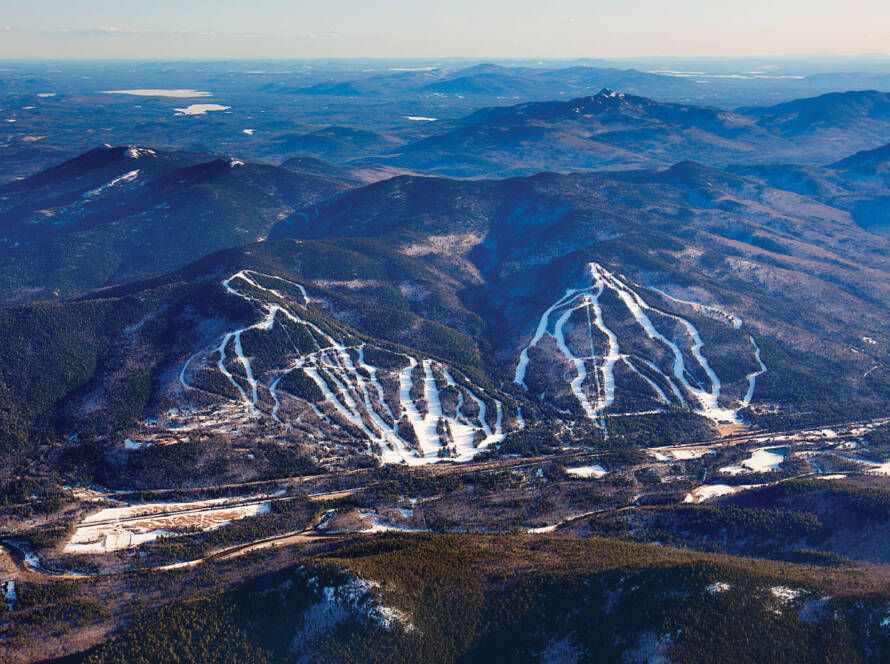By Candice G. Ball
The design of ski resorts wasn’t exactly simple in the late 1950s, but the business of skiing centered around selling lift tickets and maybe a hot dog or hamburger. Today, mountain resorts operate year-round and offer everything from ziplining and yoga retreats to fat biking and wine tasting.
SE Group has not only evolved with the ski resort industry over the last 60 years, but it has also led some of the evolution by proactively responding to regulatory changes, environmental issues and marketplace demands. Since 1958, SE Group has completed 2,500 ski resort projects around the world, making it a formidable force in the industry.
Back in the late 1950s, project concepts focused more on ski area development and the discipline behind lift and trail design as opposed to mountain resorts. “The planning revolved around creating the trails and figuring out where the lifts should go,” said Chris Cushing, a principal with SE Group.
SE Group focused on creating a balanced experience within that simple paradigm. That involved creating trails for beginners to experienced skiers and ensuring the parking, lifts and base lodges met the participants’ needs.
“That planning capacity revolved around comfortable carrying capacity or CCC,” said Claire Humber, a principal with SE Group. “Back in the ‘50s, ‘60s and ‘70s, a lot of the work was focused [on] creating a balanced mountain ski area experience. We still do that today, but it goes beyond skiing.”
Some signature projects from the early days include Copper Mountain, Loon Mountain, Bretton Woods and Keystone.
The 1972 and subsequent amendments to the United States Environmental Protection Agency’s Clean Water Act had a profound impact on the ski resort industry. Mountain resorts are built on environmentally sensitive terrain and not all ski resort developers followed what would now be deemed sustainable or green design principles. “This was one of the factors that caused policies and regulations to become much more stringent to protect natural habitat and water systems,” Cushing said.
To stay on the leading edge of the new requirements, SE Group acquired an environmental consulting firm in the early 1980s and expanded its services to include environmental permitting.
The next major shift in the ski industry occurred in the late 1980s, when ski resorts became much more elaborate with expanded recreational activities, amenities, services and overnight accommodations.
21st-century mountain resorts
To meet the growing demand for designing complex, sustainable mountain resorts and communities, SE Group merged with a landscape and architecture company, expanding services to include detailed landscape and architectural planning and site design as well as land planning. SE Group also expanded its environmental services to include public lands projects.
“Many resorts were hosting hundreds of thousands of visitors every winter and operations shut down in the summer. That is not sustainable,” said Cushing, referring to the one-season paradigm that many resorts are finding is no longer viable to remain profitable. Most mountain resorts have evolved to offer year-round attractions, including mountain biking, ziplining, bungee jumping and festivals.
SE Group helps its clients with everything from strategic planning, permitting and design to construction. It currently has 150 projects on the go, including its largest project to date which is being built in China.
When it comes to planning a mountain resort, every project is different and the timelines can be long. For instance, SE Group began working on British Columbia’s Revelstoke Mountain Resort in 1992 and it opened for business 15 years later.
“Revelstoke was an interesting project because here’s a resort that has one of the highest vertical drops of any resort in North America and is one of the largest in terms of skiable terrain, around 3,000 acres, all serviced by four lifts, which is staggering,” said Cushing. “If you look at other resorts with that amount of terrain, and they have four times that number of lifts.”
SE Group’s challenge when working on Revelstoke was to manage the budget because there was no expectation that they would have high visitation during the first phase. The quandary was how does SE Group create an affordable lift system that also creates a great ski area?
The lift network they designed achieved both goals through smart design. “The way the geomorphology sits, we were able to access a lot of terrain with one lift,” said Cushing. “It’s an interesting case study of what it takes to build ski resorts and the different factors that come into play. The phasing of it is always the most challenging part. How do you implement phases in an affordable way that will pay for the next phase? It has to be a sustainable business plan.”
One of the first things that SE Group focuses on is helping ski resorts offer visitors a wide variety of experiences on the terrain. “Terrain variety is the industry term. That means having a really well-rounded groomed terrain network,” said Peter Williams, a senior mountain planner with SE Group. “But also offering access to different types of skiing, including chutes, glades and bowls, or a cat skiing area. There is a lot of interest in cat skiing, the backcountry experience, while still being at a resort.”
SE Group also focuses on helping resorts plan all-season operations. “One of the biggest changes is that we no longer think this is summer and this is winter, and they are separate. We think of it as a more holistic operation that is expanded,” said Humber. “We are also looking to build on the existing operational infrastructure for summer activities.”
Another consideration is that the summer visitors may have different interests than the winter guests. “It’s not just about what is possible from a physical perspective. It also has to be feasible from a market perspective,” said Humber.
Breckenridge Ski Resort is an example of a resort that offers a full roster of summer experiences such as the Epic Discovery Alpine Camp, which includes ziplining, climbing and hiking. “That is in direct response to the fact they are located in a high-tourist traffic area in Colorado, full of families on vacation looking for things to do,” said Humber.
In contrast, Telluride Ski Resort focuses more on summer festivals that run the gamut from the famous Telluride Bluegrass Festival to film festivals and farmers’ markets. “The reason they do that is because they are off the beaten path,” said Humber. “They have to attract people to come for the weekend and be able to entertain them for a weekend.” Another example of out-of-the-box thinking is Utah’s Snowbird Resort’s Oktoberfest which runs from August 17 to October 20.
In a competitive industry, having a strong brand which differentiates a resort is key. SE Group helps clients to diversify operations and guests’ experiences while maintaining the integrity of their brands. “Having a strong brand presence is critical to offering an authentic and unique experience,” said Humber.
Climate change brings new challenges
Climate change has made winters warmer and shorter which complicates mountain resort planning and design. “How can we build a ski resort that may not have snow in 10 years?” asked Cushing. “We are increasingly having to rely on making snow.” Snowmaking adds water to the mountain, making good drainage systems and sediment control systems necessities.
With less snow, some ski trails are designed to be narrower because that requires less snow coverage. Additionally, modern advances have made for significant increases in the energy-efficiency of snowmaking technology.
Despite these challenges, SE Group continues to find ways to innovate, making them one of the most sought-after firms for resort design. “No project is too big or too small,” said Williams. “We work completely across the industry on small community projects to large international resorts.”
In 2018, SE Group celebrated 60 years. The longevity is a testament to their ability to adapt to environmental and marketplace challenges. Cushing jokes that every new decade seems to usher in seismic changes to the ski resort industry. Clients can rest assured that SE Group is ready for 2020.


![[image placeholder]](https://www.snowopsmag.com/wp-content/uploads/2023/09/placeholder@2x-890x664.png)
